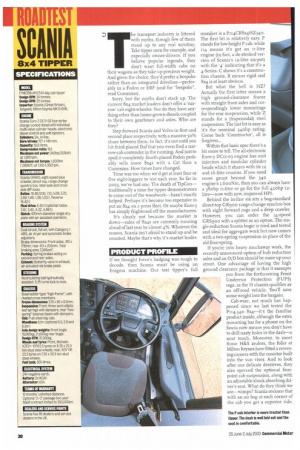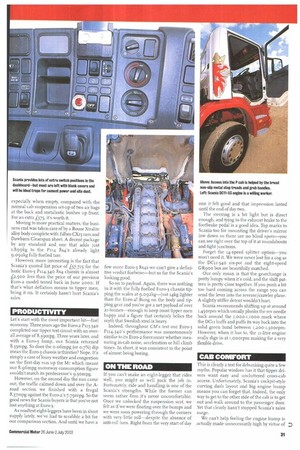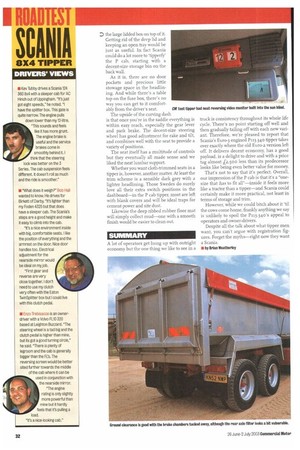he transport industry is littered with myths, though few of
Page 30

Page 31

Page 32

If you've noticed an error in this article please click here to report it so we can fix it.
them stand up to any real scrutiny. Take tipper men for example, and especially owner-drivers. If you believe popular legends, they don't want full-width cabs on their wagons as they take up precious weight. Arid given the choice, they'd prefer a bespoke rather than an integrated driveline—preferably in a Foden or ERF (and for "bespoke", read Cummins).
Sorry, but the myths don't stack up. The current 8x4 market leaders don't offer a `narrow' cab eight-wheeler. Nor do they have anything other than home-grown diesels coupled to their own gearboxes and axles. Who are they?
Step forward Scania and Volvo in first and second place respectively, with a massive 50% share between them. In fact, it's not until you hit third-placed Dot that you even find a narrow-cab contender in the running. And just to spoil it completely, fourth-placed Foden probably sells more 8x4s with a Cat than a Cummins. How times have changed.
Time was too when we'd get at least four or five eight-leggers to test each year. So far in 2003, we've had one. The death of TipContraditionally a time for tipper demonstrators to come out of the woodwork—hasn't exactly helped. Perhaps it's become too expensive to put an 8x4 on a press fleet. Or maybe Euro-3 has simply frightened off the manufacturers.
It's clearly not because the market is down—sales of 8x4s are currently running ahead of last year by almost 4%. Whatever the reason, Scania isn't afraid to stand up and be counted. Maybe that's why it's market leader.
PRODUCT PROFILE
If we thought Iveco's badging was tough to decode, then Scania must be using an Enigma machine. Our test tipper's full moniker is a Pit4CB8 The first bit is relatively easy. P stands for low-height P cab, while 114 means it's got an It-litre engine (in fact, a de-stroked version of Scania's 12-litre six-pot) with the '4' indicating that it's a 4-Series. C shows it's a construction chassis, B means rigid and 8x4 is at least obvious.
But what the hell is HZ? Actually the first letter means a high ground-clearance frame with straight front axles and correspondingly lower mountings for the rear suspension, while Z stands for a (trapezoidal) steel suspension. The last bit is easy as it's the nominal 34ohp rating. Come back 'Constructor', all is forgiven...
Within that basic spec there's a bit more to tell. The all-electronic Euro-3 DC11..03 engine has unit injectors and modular cylinder heads which it shares with its 12 and 16-litre cousins. If you need more grunt beyond the 34o engine's ikooNm, then you can always have a 380hp or go for the full 420hp 12litre—now with new, improved H P I.
Behind the in-line six sits a bog-standard direct-top GR9oo range-change synchro box with eight forward cogs and a deep crawler. However, you can order the r4-speed GRS9oo with a splitter as an option. The single-reduction Scania bogie is tried and tested and ideal for aggregate work but now comes with a two-spring suspension in place of the old four-spring.
If you're into heavy muckaway work, the recently announced option of hub reduction axles and an O/D box should be more up your street. One advantage of having the high ground clearance package is that it exempts you from the forthcoming Front Underrun Protection (F UP S) regs, as the H chassis qualifies as an off-road vehicle. You'll save some weight into the bargain.
Cab-wise, not much has happened since we last tested the P114.340 8x4—it's the familiar product inside, although the extra mounting bar for a phone on the fascia now means you don't have to drill nasty holes in the dash—a neat touch. Moreover, to meet those H8cS zealots, the folks at Milton Keynes have fitted a reversing camera with the monitor built into the sun visor. And to look after our delicate derrieres, they also specced the optional fourpoint cab suspension, along with an adjustable shock absorbing driver's seat. What do they think we are—wimps? Scania reckons that with an air bag at each corner of the cab you get a superior ride,
especially when empty, compared with the normal cab suspension set-up of two air bags at the back and metalastic bushes up front. For an extra L'375, it's worth it.
Moving to more practical matters, the business end was taken care of by a Rouse Xtralite alloy body complete with Edbro CX15 ram and Dawbarn Clearspan sheet. A decent package by any standard and one that adds just 1,899kg to the P114 8x4's already light 9,092kg fully fuelled tare.
However, more interesting is the fact that Scania's quoted list price of 157,715 for the basic Euro-3 Pii4.34o 8x4 chassis is almost £2,500 less than the price of our previous Euro-a model tested back in June 2000. If that's what deflation means to tipper men, bring it on. It certainly hasn't hurt Scania's sales.
PRODUCTIVITY
Let's start with the most important bit—fuel economy. Three years ago the Euro-2 Pir3.34o completed our tipper test circuit with an overall average of 8.39mpg. Three years later, and with a Euro-3 lump, our Scania returned 8.33mpg. So does the o.o6mpg (or 0.7%) dip mean the Euro-3 chassis is thirstier? Nope. It's simply a case of lousy weather and congestion on the first-day run up the MT which meant our 8.96mpg motorway consumption figure couldn't match its predecessor's 9.50mpg.
However, on the second day the sun came out, the traffic calmed down and over the Aroad section we finished with a frugal 8.37mpg against the Euro-2's 7.79mpg. So the good news for Scania buyers is that you've not lost anything at Euro-3.
As roadtest eight-leggers have been in short supply lately, we've had to scrabble a bit for our comparison section. And until we have a few more Euro-3 8x4s we can't give a definitive verdict fuelwise—but so far the Scania's looking good.
So on to payload. Again, there was nothing in it with the fully fuelled Euro-3 chassis tipping the scales at 9,092kg—lust14kg lighter than the Euro-2! Bung on the body and tipping gear and you've got a net payload of over ar-tonnes---enough to keep most tipper men happy and a figure that certainly belies the myth that Swedish steel is heavy.
Indeed, throughout CM's test our Euro-3 P114.340's performance was monotonously similar to its Euro-2 forerunner whether measuring in-cab noise, acceleration or hill climb times. In short, it was consistent to the point of almost being boring.
ON THE ROAD
If you can't make an eight-legger that rides well, you might as well pack the job in. Fortunately, ride and handling is one of the Scania's strengths. While the former can seem rather firm it's never uncomfortable. Once we unlocked the suspension seat, we felt as if we were floating over the bumps and we were soon powering through the corners with very little roll—despite the absence of anti-roll bars. Right from the very start of day
one it felt good and that impression lasted until the end of day two.
The steering is a bit light but is direct enough, and tying in the exhaust brake to the footbrake pedal is a good idea. Top marks to Scania too for mounting the driver's mirror low down so there are no blind spots—you can see right over the top of it at roundabouts and tight junctions.
Forget the 4-speed splitter option—you won't need it. We were never lost for a cog as the DC11-34o six-pot and the eight-speed GR9oo box are beautifully matched.
Our only moan is that the gearchange is pretty lumpy when it's cold, and the shift pattern is pretty close together. If you push a bit too hard coming across the range you can send the lever into the reverse/crawler plane. A slightly stiffer detent wouldn't hurt.
Scania recommends shifting up at around 1,450rpm which usually plonks the rev needle back around the 1,0 00-1,1000 mark where the DCH huffs and puffs its way back into the solid green band between 1,200-1,300rpm. However, when it has to, the ir-litre engine really digs in at r,000rpm making for a very flexible drive.
CAB COMFORT
This is clearly a test for debunking quite a few myths. Popular wisdom has it that tipper drivers want easy and uncluttered cross-cab access. Unfortunately, Scania's cockpit-style curving dash layout and big engine hump means you can forget that. Indeed, the only way to get to the other side of the cab is to get out and walk around to the passenger door. Yet that clearly hasn't stopped Scania's sales surge.
We can't help feeling the engine hump is actually made unnecessarily high by virtue of the large lidded box on top of it. Getting rid of the deep lid and keeping an open tray would be just as useful, In fart Scania could do a lot more to 'tipperfy' the P cab, starting with a decent-size storage bin on the back wall.
As it is, there are no door pockets and precious little stowage space in the headlining. And while there's a table top on the fuse box, there's no way you can get to it comfort is that once you're in the saddle everything is within easy reach, especially the gear lever and park brake. The decent-size steering wheel has good adjustment for rake and tilt, and combines well with the seat to provide a variety of positions.
The seat itself has a multitude of controls but they eventually all made sense and we liked the neat lumbar support.
Whether you want cloth-trimmed seats in a tipper is, however, another matter. At least the trim scheme is a sensible dark grey with a lighter headlining. Those Swedes do surely love all their extra switch positions in the dashboard—in the P cab tipper, most are left with blank covers and will be ideal traps for cement power and site dust.
Likewise the deep ribbed rubber floor mat will simply collect mud—one with a smooth finish would be easier to clean out.
SUMMARY
A lot of operators get hung up with outright economy but the one thing we like to see in a truck is consistency throughout its whole life cycle. There's no point starting off well and then gradually tailing off with each new variant. Therefore, we're pleased to report that Scania's Euro-3 engined 13113.34o tipper takes over exactly where the old Euro-2 version left off. It delivers decent economy, has a good payload, is a delight to drive and with a price tag almost £2,500 less than its predecessor looks like being even better value for money.
That's not to say that it's perfect. Overall, our impression of the P cab is that it's a "onesize that has to fit all—inside it feels more like a tractor than a tipper—and Scania could certainly make it more practical, not least in terms of storage and trim.
However, while we could bitch about it 'til the cows come home, frankly anything we say is unlikely to spoil the P113.34o's appeal to operators and owner-drivers.
Despite all the talk about what tipper men want, you can't argue with registration figures. Forget the myths—right now they want a Scani.2.
• by Brian Weatherley




































































































































































